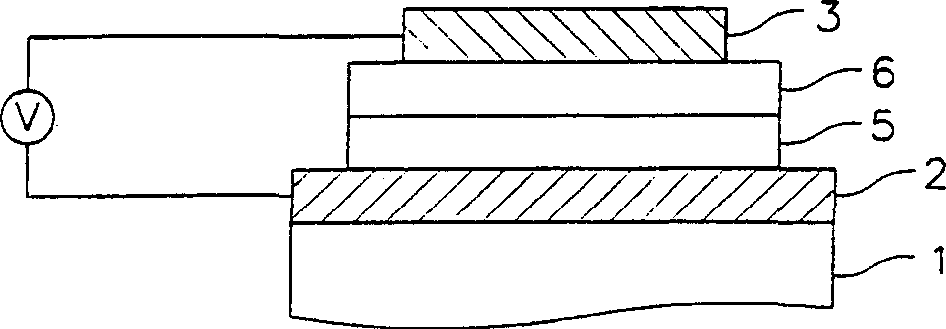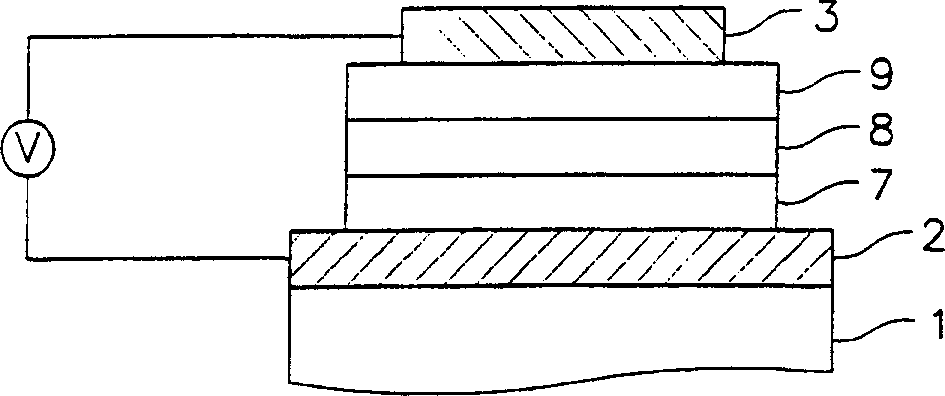Organometallic complex molecule and organic electroluminescent device using the same
A technology of organometallic complexes, which is applied in the field of organic EL devices, organometallic complex molecules, and organic electroluminescent devices, and can solve problems such as high driving voltage
- Summary
- Abstract
- Description
- Claims
- Application Information
AI Technical Summary
Problems solved by technology
Method used
Image
Examples
Embodiment 1
[0059] Organometallic Complex Example 1: Synthesis of Chemical Formula (2) Preparing the Ligand Precursor of Chemical Formula (13)
[0060] Inject 50 ml of dimethylsulfoxide (DMSO) into the nitrogen-purged vessel. Next, 2.5 g of 4-hydroxycoumarin and 2.1 g of phenylisothiocyanate were added and dissolved in DMSO, thereby forming a mixture. 1.55 g of triethylamine was added to the mixture, and the components in the mixture were reacted while stirring at room temperature for 2 hours. After the reaction was completed, the reaction solution was added to 100 ml of 3N hydrochloric acid to form a yellow solid. The yellow solid was then dried and recrystallized in 200 ml of acetone to obtain 2.4 g of the compound of formula (13) shown below with a yield of 52%. Chemical formula (13) Preparation of ligands of formula (14)
[0061] 0.2 g of the compound represented by the above chemical formula (13) was dissolved in 10 ml of chloroform, and 0.034 ml of bromine was s...
Embodiment 2
[0065] Measured value: C (58.8), H (2.3), N (4.1), Zn (9.6) embodiment 2: synthetic chemical formula (10) prepares the ligand precursor of chemical formula (15)
[0066] 5 g (28.54 mmol) of 4-hydroxy-N-methylquinoline was dissolved in 85 ml of DMSO to form a mixture, and then 4 ml of triethylamine was added to the mixture and stirred for 10 minutes. Next, 3.46 ml of phenyl isocyanate was added to the DMSO solution, and left to react while stirring at room temperature for 1 hour. After the reaction was completed, the reaction solution was added in 3N hydrochloric acid. The precipitate formed during the reaction and the addition of aqueous hydrochloric acid was subsequently stirred and washed with water, then dried in vacuo. The dried precipitate was recrystallized in acetone to obtain 1.8 g of the compound of the following chemical formula (15) in a yield of 20%. Chemical formula (15) Preparation of ligands of formula (16)
[0067] 1.69g (5.44mmol) of the compound represen...
Embodiment 3
[0072] Measured value: C (60.05), H (3.26), N (8.24), Zn (9.61) embodiment 3: synthesis chemical formula (6) prepares the precursor of chemical formula (17)
[0073] 50 g of diphenyl ether were added to a mixture consisting of 16.9 g of diphenylamine and 32 g of diethyl malonate. The resulting mixture was refluxed at 250° C. for 5 hours, cooled to 100° C., and then 50 ml of 1,4-dioxane was added to the mixture solution to obtain a precipitate. After 12 hours, the precipitate was filtered, washed with 1,4-dioxane ether, and then dried in vacuo to obtain 25.4 g of the compound of formula (17), with a yield of 83%. Chemical formula (17) Preparation of the precursor of formula (18)
[0074] 24.4 g of the compound represented by chemical formula (17) was added to a mixture solution containing 250 ml of ethylene glycol, 25 ml of water, and 16 g of sodium hydroxide. The mixture solution was left to react while stirring at a temperature of 100° C. for 1 hour. After cooling the re...
PUM
| Property | Measurement | Unit |
|---|---|---|
| Melting point | aaaaa | aaaaa |
| Melting point | aaaaa | aaaaa |
| Melting point | aaaaa | aaaaa |
Abstract
Description
Claims
Application Information
 Login to View More
Login to View More - R&D
- Intellectual Property
- Life Sciences
- Materials
- Tech Scout
- Unparalleled Data Quality
- Higher Quality Content
- 60% Fewer Hallucinations
Browse by: Latest US Patents, China's latest patents, Technical Efficacy Thesaurus, Application Domain, Technology Topic, Popular Technical Reports.
© 2025 PatSnap. All rights reserved.Legal|Privacy policy|Modern Slavery Act Transparency Statement|Sitemap|About US| Contact US: help@patsnap.com



